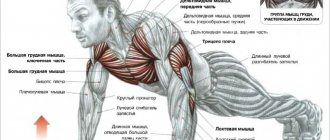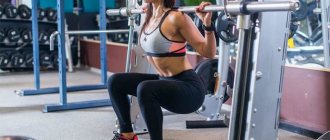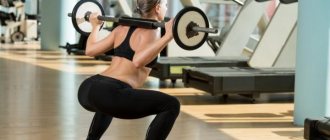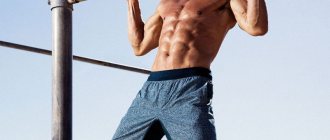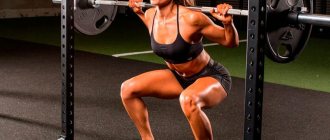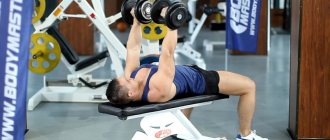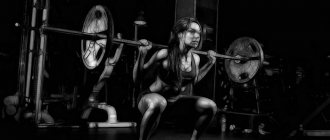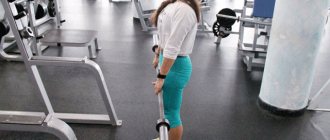In this article, you will learn how to do the back squat with perfect form, as well as how to improve your performance in this exercise.
Key points:
- Barbell squats are one of the best exercises for developing such important muscles and muscle groups in your body as the quadriceps, hamstrings, back muscles, buttocks, and calves.
- Learning the correct technique consists of learning some techniques that form the habit of performing this exercise correctly. I will tell you about them below.
- The classic back squat is a widely recognized effective type of squat, but I suggest looking at the front squat, the Bulgarian squat, and the goblet squat. These exercises are also very effective.
Squats
Squats are one of the most important basic exercises in bodybuilding, fitness and powerlifting. Of course, you can find other exercises to develop your back and leg muscles, but the main benefit lies in developing your overall physical strength. But at the same time, this exercise is very difficult to master.
Squats engage every major muscle group in your body, forcing them to work in harmony and synchronization to generate incredible strength. You need to remember that if you want to squat with serious weights and also avoid injury, you must follow the correct technique. You can use cheating on the bench press or even the deadlift, but cheating won't help with the squat. If you don't have the strength and proper technique, you won't move the weight. After reading this article, you will learn how to master the squat with perfect form, different variations, and 12 ways to improve your performance. I will also present a simple and effective training program.
Let's get started!
What muscles are involved during squats?
The squat is a unique exercise that works every major muscle group in your body except the arms, chest, and shoulders. In particular, squats will help you develop muscles such as:
- Quadriceps
- Biceps hamstrings
- Gluteal muscles
- Hip flexors
- Spinal stabilizer muscles
- Latissimus dorsi muscles
- Trapeze
- Calf muscles
As you know, many muscles in the body are antagonists to each other. For example, biceps-triceps, when you perform some kind of biceps exercise (barbell lifting or some other), your triceps practically do not work. Obviously, engaging the triceps in this case will not help you with the biceps exercise. The leg muscles - quadriceps and hamstrings - are also antagonists. But due to an amazing feature of human anatomy called Lombard's paradox, squats involve both muscles at the same time. It is for this reason that they are so effective and yet so complex.
Execution technique
There are many variations of performing reinforced squats, and the technique is different for everyone.
The main exercise is performed as follows:
- Approach the rack where the barbell is located at a convenient level. You cannot move away from the rack while performing a squat.
- Sit down slightly under the apparatus, this will tighten the trapezius muscle.
- Hold the barbell so that your palms cannot touch your shoulders.
- Gently straighten your legs and immediately take a small step forward.
- Place your feet at a comfortable width, turning them at an angle of 45 degrees. Watch your back, it should be perfectly straight.
- Sit down carefully. As soon as the maximum low point of the squat is reached, immediately straighten up slowly. Under no circumstances should you linger in this position; it will not bring any benefit, but it can cause harm.
- Repeat as many times as necessary.
For men
The number of exercises for men with a barbell weight of 20 to 30 kg varies from 10 to 15 approaches. If you are gaining muscle mass, then you can perform 5 approaches 6-8 times, and during the drying period it is better to do more repetitions - 10-12, the number of approaches is the same - 5 times.
For girls
Girls should perform approximately 8-12 repetitions, with a load on the shoulders of 10-15 kilograms.
In the Smith machine
This exercise is convenient because the athlete does not need to independently control his back; he can lean on the bar. The starting position is the same as for a regular squat. The Smith machine is ideal for girls.
Sumo
The peculiarity of this technique is that squats are performed with a wide stance. But sumo is not recommended for those who have problems with the hip joints. Due to the fact that your legs are wide apart, you won't be able to do a deep squat, so you shouldn't try to do it. The thigh and gluteal muscles work well.
Frontal
The difference between front squats is that the machine is taken not on the shoulders, but on the chest. The athlete takes the bar with a straight grip, with his feet shoulder-width apart. You need to squat so that the lower surface of the thigh is in full contact with the calf muscles. Elbows point forward, back straight. Then return to the starting position.
Zerchera
In this technique, the barbell is also placed on the chest while performing the exercise. However, in the initial position, the bar is not on the rack, but on the floor or platform. The athlete carefully squats, takes the barbell with a comfortable grip and places the apparatus so that it is above the inside of the elbow. Some athletes try to place a towel on their hands to avoid discomfort.
Then you need to clasp one hand with the other, holding the projectile tightly and avoiding its rotation. The barbell is pressed tightly to the body, the legs are wider than the shoulders. Gently straighten up, pushing your heels off the floor and squeezing your buttocks. Then sit back down. Repeat as many times as necessary.
With a narrow stance
Such exercises are considered moderately difficult.
First you need to prepare the starting position. Take the barbell on your shoulders with your usual grip, going slightly under it, feet together, toes apart. In this case, you need to tense your abs and make sure that your back is perfectly straight.
The athlete gradually lowers down, reaching a right angle of 90 degrees, you need to slowly straighten back up. Repeat the required number of times.
In a lunge
This version of the squat with a barbell on the shoulders is also worthy of attention.
To perform it, you need to place your feet shoulder-width apart, take the barbell with a comfortable grip and remove it from the rack, then place it just below your neck. Take a wide step forward and lock your stance. The step should be such that the knee on the working leg is bent at a right angle. The supporting leg can stand either on the floor or on a small platform.
Then the athlete lowers himself slightly into the lunge, making sure that the knee of the working leg does not go forward, beyond the line of the toe. The back is straight. Then, with an effort, the athlete pushes himself out of the lunge and stands up straight, with the barbell on his shoulders. During the exercise, you need to do everything carefully and gently, no sudden movements.
How to squat with perfect form?
Complex multi-joint (basic) exercises require strict adherence to the correct technique. Otherwise, such exercises may injure you. Let's look step by step at how to learn how to squat correctly and look at all the nuances in detail, including each element of the movement, shoes, additional equipment and even nutrition. First, watch the first few seconds of the following video to get an idea of what we're talking about.
Next, let's look at three steps to mastering proper technique, starting from the starting position.
How to do squats at home correctly
You should make every effort to ensure that everyone admires your lower body. We have put together for you several simple but basic exercises, without which it is almost impossible to pump up your buttocks. Today you will learn how to do squats correctly. Buy comfortable sneakers and sportswear, and feel free to go to the gym.
If you don’t have extra money today, you can start practicing at home. The mechanism for performing standard squats is quite simple. It will require you to place your feet shoulder-width apart and place your hands behind your head. This is the starting position. Always do it correctly and then you will reduce the likelihood of injury many times over. Often girls are chasing quick results and one of their lower limbs is damaged. This happens due to the fact that they do not get into the starting position correctly and do squats incorrectly. This threatens with injuries and torn ligaments. Another question that worries girls so much is how many squats to do.
We do not recommend you start with a large number of approaches and number of times. You may simply not straighten up the next day. You should start by creating a training schedule for yourself with a gradual increase in the number of approaches and repetitions. The key word here is gradual.
Alternative types of squats
The back squat is just one type of squat, there are others:
- Front Squats
- Bulgarian squats
- Goblet Squats
You can use each of these variations instead of or in addition to classic squats to add variety to your program. Let's take a closer look at each of these options.
Front Squats
Front squats are my favorite leg exercise. In general, the movement itself below the belt remains almost the same as with classic squats. The key difference is that the barbell does not lie on your back, but is held on your shoulders in front.
It looks like this:
The advantage of the front squat is that it places more emphasis on the quadriceps and upper back, and that it allows for a much deeper range of motion. The disadvantage of front squats is that you can use significantly less weight than with the classic version, and front squats may also seem less comfortable to some.
Front squats also require some mobility in your wrists, which is why some people hold their hands like this:
This grip is more comfortable, but it is less stable and does not allow you to work with heavy weights. I would recommend not crossing your arms, even if you can only grip the bar with one or two fingers.
Also, when performing front squats, it is possible to place your legs much closer to each other - at shoulder width or even narrower. This allows you to shift the load to the outer part of the quadriceps while maintaining deep amplitude.
Bulgarian squats
It is not without reason that Bulgarian squats have become increasingly popular lately. They look like this:
Research shows that this exercise can actively affect your strength in the classic squat, and specifically your one-time maximum. Bulgarian squats significantly reduce the load on the lower back, and also involve more of the hamstrings, which are less actively involved in the frontal version. This exercise also allows you to concentrate on working each leg separately, focusing your attention on the work of target muscle groups.
The disadvantage of Bulgarian squats is that the working weight, of course, will be significantly less than in other types of squats. This exercise falls more into the auxiliary category.
Goblet Squats
Goblet squats are technically very similar to front squats, the difference being that you use dumbbells instead of a barbell. They look like this:
Hold the dumbbell in front of you and do not let it move away from your chest. The main advantage of this type of squat is that you don't need a barbell to perform it. If you are traveling or practicing at home, this exercise can be a good alternative. This exercise will also be useful if for some reason you experience pain in the shoulder girdle or back when doing squats with a barbell.
Description
The squat with a barbell is considered one of the main exercises in bodybuilding. It helps develop the muscles of the thighs and buttocks. Squats are used not only in professional sports, but also for general development and strengthening of the figure.
How to squat with a barbell correctly: an athlete with a barbell on his shoulders stands with his feet shoulder-width apart. Then he squats and then stands up, returning to his starting position.
There are several subtypes of the squat exercise:
- Complete. In this case, the athlete tries to sit as low as possible. At the same time, you need to make sure that the pelvis does not tilt back too much. Ideally, when performing a squat, the calf muscles should be in contact with the back surface of the athlete's reed.
- Deep. When performing, try to squat with the barbell so that the athlete’s thighs are parallel to the floor.
- Half squat. One of the easiest positions. When doing a half-squat, only one condition is met - you need to bend your legs at a right angle at the knee, while the thigh bones must be in a horizontal position.
- Partial. This subtype of exercise includes any squat in which the athlete’s knee bend angle does not reach 90 degrees.
What muscles are involved?
To gain muscle mass, you need to use the exercise “squats with a barbell on your shoulders.” This activity is the most effective exercise, as it activates many of the most important muscles of the body, while many joints work.
While working with a barbell, almost all the muscles of the body come into motion, there are more than 250 of them. These include such as the muscles of the thigh, back, gluteal muscles, muscles of the back of the thigh, all the muscles of the legs, as well as the abdominal press.
What are the benefits of a barbell squat?
Deep power squats are primarily beneficial for men. Surprisingly, it is during exercise with a barbell on the shoulders that the production of testosterone increases in the male body. This is the main anabolic hormone responsible for endurance, strength, sexual health, and well-being of guys. A man of any age can perform this exercise if there are positive medical indications.
In addition to men, the barbell technique is a very useful exercise for women as well. It is the squat that makes it possible to get beautifully defined buttocks. The exercise puts stress on the gluteal and thigh muscles. If you squat intensely enough, you can burn more calories than running on a treadmill for half an hour. If you need to dry out your body a little and achieve sculpted muscle definition, then enhanced squats are the right choice.
Possible harm
Even this generally positive exercise has a harmful side.
- To master the squat with a barbell, the technique of which is quite complex, you will have to spend a lot of time before achieving the first results.
- The exercise requires a lot of energy, it is necessary that the abdominal and back muscles are sufficiently trained and prepared before starting training with a barbell on the shoulders. If your back muscles are weak, you won't be able to carry enough weight on your shoulders to positively influence the development of your lower body muscles. A weak press will not allow you to perform the exercise correctly; the athlete will simply bend over, although when performing a squat, the back should be absolutely straight.
- Even when an athlete performs an exercise absolutely correctly, he experiences enormous stress on the spine. If you start with a small weight of the barbell on your shoulders, then this is not particularly harmful, but there is no particular benefit either. Over time, it is necessary to increase the compression load on the spine. This is especially dangerous when the squat is repeated a small number of times, and the weight is taken on the shoulders very heavily.
Contraindications
As with any complex physical exercise, there are many contraindications to the barbell squat:
- various diseases of the spine;
- phlebeurysm;
- problems with hip and knee joints;
- diseases of the cardiovascular system;
- scoliosis;
- hypertension;
- radiculitis;
- hernia.
You can perform the exercise if you have such health problems, but only after consulting your doctor and under the close supervision of a professional trainer. An alternative to a full workout can be squats with a bar on your shoulders without additional weight. If pain occurs when performing a technique with a bar or barbell, you should stop training and consult a doctor.
Simple and effective training program
You know how to squat, you're familiar with the different variations. It's time to get to work.
Below is a workout program that includes various types of squats, as well as additional exercises for the hamstrings and calves.
- Warm up, then:
- Squats with a barbell on the back. Low or high position. For advanced: 3 sets, 4-5 reps, weight 80-85% of one-time maximum.
- For beginners: 3 sets, 8-10 reps, weight 70-75% of one-time maximum.
- 3 sets, 4-6 reps for advanced, 8-10 reps for beginners. Weight is 70-80% of the one-time maximum.
- 2 sets, 4-6 reps for advanced, 8-10 reps for beginners, weight 70-80% of one-time maximum.
- 2 sets, 4-6 reps for advanced, 8-10 reps for beginners, weight 70-80% of one-time maximum.
- 3 sets, 8-10 reps, weight 70-80% of one-time maximum.
There are several options for performing this workout. Please note the following features.
It is not necessary to achieve complete muscle failure in every approach.
Muscle failure is a condition where you can no longer continue to perform a set with a given weight. I personally never train in failure mode on every set. I always finish the set 2-3 reps before failure, especially on exercises like the squat, deadlift, bench press, or military press. Failure to do these exercises can cause injury. Instead, I save my strength for sets of isolation exercises such as machine leg curls (hamstrings), machine leg extensions (quadriceps), calf raises, and others.
Rest 3-4 minutes before each approach
This will allow the muscles to rest enough to regain strength to fully perform the next approach or exercise.
If you reach the upper limit of your rep range, add weight
For example, if you squat 60kg 6 times or more on your first set, add another 5kg to your weight on your next set. If you have completed at least 4 reps with a weight of 65 kg, continue with the same weight until you reach the upper limit of 6 reps again. If you can do 3 or fewer reps, then the weight is too heavy for you, choose a weight that allows you to stay in the 4-6 rep range and work with it until you feel confident.
What squats are considered the most effective?
You also have to watch your own heels. You should not tear them off the floor, as they can injure the lower limb. If your body structure does not allow you to follow this rule, then you can place some objects under your heels. Squats are a simple but very effective exercise. Don't forget that you can perform the most effective exercises even at home, you just have to know how to do them correctly. You need to start by learning how to squat correctly. How many squats you need to do is another question. If your goal is strong buttocks in a short time, then you can complicate standard squats. You can start squatting with dumbbells on your shoulders. This is a fairly effective exercise that increases the load on the body and helps bring your butt into perfect condition in a short time.
You can try doing deep exercises. They can help you get rid of cellulite and even pump up the inner thigh muscles. You need to decide how many squats to do per day. Let it be three approaches of 15 times. This is quite a serious load on the legs, and it will definitely give the desired effect. You need to understand that beautiful buttocks and thighs are not so easy to achieve.
Summarize
Squats are one of the best exercises for developing not only the muscles of your legs and back, but also for developing all the systems in your body responsible for developing strength in general. I'm talking about the nervous system, the neuromuscular connection, the cardiovascular system, the hormonal system, and other important body systems that are directly or indirectly responsible for strength and endurance.
It's no secret that squats have a so-called “hormonal response.” An incredible amount of research has been conducted, during which it has been repeatedly discovered that performing squats causes an active release of anabolic hormones into the blood, including testosterone. It is with this that many associate the effect that squats have on the development of strength and muscle volume. There is a good expression: “If you want to have big biceps, do squats.”
In this article, we examined in detail the technique of performing squats, various options for performing them, such as front squats, Bulgarian squats and goblet squats.
Even if you follow all the instructions correctly, you can, sooner or later, get into stagnation, this happens to all trainees sooner or later. If you find yourself in such a situation, use the methods I described above. In order to progress continuously and fully experience the benefits of this exercise, let’s summarize all of the above:
- Continue to work on proper squat form.
- Work on the mobility of your joints - hip, knee and ankle.
- Experiment with execution technique (grip, foot placement, etc.)
- Work with heavy weights.
- Use your equipment.
- Keep the right attitude.
- Use explosive technology.
- Squat more often.
- Use different squat variations.
- Eat right.
- Use the microload method.
- Use additional exercises to develop your legs and back.
Squats: hard worker muscles, reputation of the exercise, who is it suitable for
Squats with a barbell on the shoulders are great for both beginners building their own body and those experienced in the “iron business,” regardless of the goals of the training process - be it increasing mass, strength, or endurance training. If your legs are thin, you should squat; if you don’t like your buttocks, then you should squat. In addition, proper squats are also suitable for girls, helping them to form beautiful shapes of their hips and buttocks.
Squats are also suitable for girls
What muscles work? These are the quadriceps, the adductor muscles of the thigh, the gluteal muscles, the extensor muscles of the back, the abdominal muscles, part of the triceps surae muscle (soleus), and the gastrocnemius.
The squat has a negative reputation, created by illiterate talkers. It’s as if the knees wear out during a squat, the menisci fly off, and the spine, after several years of active exercise, simply crumbles into your underpants. What can you say: “Make a fool pray to God, he’ll bruise his forehead.”
Be smart! Understand the theory, acquire knowledge, consolidate it with skills, and progress in this exercise without harming your health.
